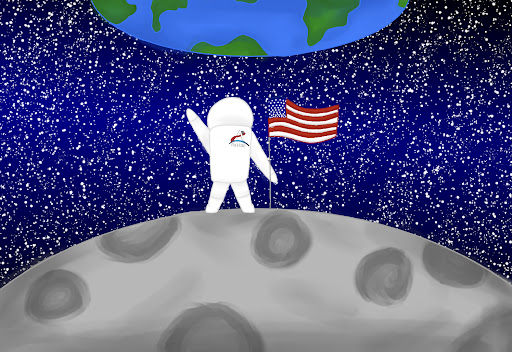The Artemis Generation: To the Moon and Beyond

Picture by Ashlee Guardado
NASA’s Apollo 11 was the first crewed mission to land on the Moon. It consisted of Neil Armstrong, Buzz Aldrin, and Micheal Collins. During the Apollo missions, 24 astronauts went to the Moon, and 12 of those men were able to walk on it. The last crewed mission sent to the Moon was the Apollo 17, launched in December of 1972. NASA started the Artemis program in December 2017, ushering in a new generation of Moon exploration and beyond.
Former NASA Administrator Jim Bridenstine explained, “This new era of lunar exploration is called Artemis. Named after the twin sister of Apollo, she is the Goddess of the Moon, and we are the Artemis Generation.” This new generation aims to explore regions of the Moon never attempted before. Moreover, they are doing this using newly developed spacecraft: the Orion and the Space Launch System.
Humans will take the Orion spacecraft to the Moon and beyond. The prime contractor for building the spacecraft is Lockheed Martin, selected by NASA for their superior technology necessary for deep space exploration. This includes the world’s largest heat shield and advanced propulsion systems, life support systems, and deep space communication and navigation.
NASA’s Space Launch System, or SLS, will send the Orion capsule to the Moon. The SLS maintains unprecedented power and capabilities; it is the most powerful rocket in the world, the only rocket that can send the Orion, astronauts, and cargo straight to the Moon on a single mission.
In early April of 2022, NASA conducted a wet dress rehearsal of the Artemis I, where teams practiced the fuel-loading process and the de-tanking procedure of the spacecraft. The rehearsal, scheduled for Sunday, April 3, and Monday, April 4, failed due to an issue maintaining helium purge pressure on the upper stage engine. The next test is scheduled to start on Saturday, April 9, and end on April 11. Once the wet dress rehearsal finishes successfully, NASA will set the official launch date for the Artemis I.
The Artemis I is currently scheduled to launch in June 2022. The mission is a flight test of the SLS and the Orion to the Moon. No astronauts will be aboard the Artemis I, but the launch of the Artemis II by 2024 will have a crew of four astronauts, including the first woman to ever land on the Moon. The Artemis III and future mission goals include building a base camp on the Moon and a gateway in lunar orbit that will allow for more exploration and discovery.
NASA’s ambitious exploration goals are not limited to just the Moon. The Artemis Generation plans for sustainable lunar exploration by 2028 and will then prepare for the next giant leap in space exploration: sending astronauts to Mars.

Hello everyone; my name is Sabrina Redifer. I am a senior at QHHS and play varsity golf. This is my second time in Journalism, and again, I’m excited...

Hey! I am Ashlee Guardado, and this is my final year in Journalism. I am a senior and have been an honors/AP student since middle school. I’m an assistant...





